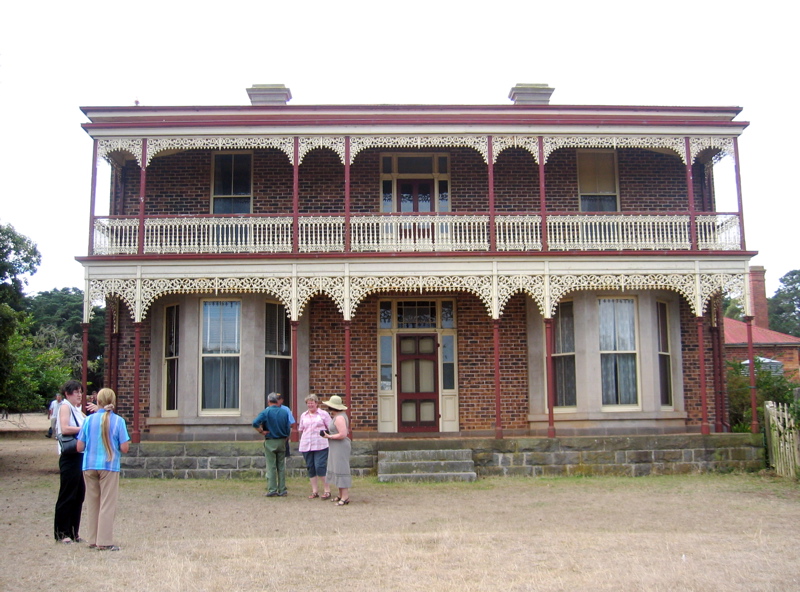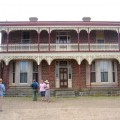Nagorcka Weekend at Tarrington
by John Noack, Betty HufOur Wendish Heritage Society and the descendants of Christian and Emilie Nagorcka (who had twelve children) celebrated the 150th Anniversary of the arrival of the Nagorcka ancestors in Australia in 1857 on the ship Gottorp. We visited Tarrington’s Nagorcka Sites on 8-9 March 2008.
A program from 12 noon Saturday to 5pm Sunday was very well organised by our Treasurer Clay Kruger and Local Historian Betty Huf. A local reporter Brian O’Brien wrote an illustrated article which described very well both this celebration and the contribution of the Nagorcka family to the District. His article was published in the Saturday Magazine of the local Hamilton Spectator titled “A huge impact on Hamilton region”. He noted that in Europe, Christian had been a groom in the stables of the Prussian King Friedrich Wilhelm III and that nearly all of the early settlers in the Tarrington and Hamilton district were Slavic Wends from Lusatia south-east of Berlin. These included the Burger, Deutscher, Handreck, Harnath, Kosch, Krause, Kruger, Lehmann, Matuschka, Mirtschin, Pertzel, Petschel, Rentsch, Salzke, Schmidt, Starick, Voight and Urban families.
Following Saturday’s midday lunch, participants visited five Nagorcka family sites and locations: Kitset Kitchens, Waltanna, Ovalbank formerly Peitz, Hochkirch Winery and the Tarrington Homestead. Betty Huf prepared these notes and a map of these five sites and Saturday afternoon was spent inspecting these Nagorcka sites.
Kitset Kitchens
In 1946 Stanley Nagorcka opened a joinery business in partnership with Doug Yuill. “Nagorcka & Yuill” was initially located in Lonsdale Street Hamilton. Stan was a true craftsman and the business supplied quality timber joinery, doors, windows and cabinetry throughout the district. The business outgrew the central premises and relocated to Carmichael St in 1957. Staff at that stage numbered 48.
Regional decentralisation and good rural economy allowed the business to prosper and by 1990 the business had expanded beyond traditional joinery to glass, aluminium, and hardware & timber supplies and was relocated to the current premises.
In 1992, after seeing the trends of modern manufacturing in Europe and America, and considering the downturn in the rural economy, Stan’s children Mark and Mary Ann focussed the business on the production of flatpack kitchens. The kitchens are flatpack, self-assembly kitchens which are freighted to all parts of Australia.
The Nagorcka Joinery company now trades as Kitset Kitchens and has showrooms in Ballarat, as well as the Melbourne suburbs of Thornbury & Moorabbin. Stanley Nagorcka’s grandchildren Ruben Nagorcka & James Callinan are also both currently active in the business.
Waltanna
In 1975, James Nagorcka built his first four-wheel drive tractor using components from various manufacturers. He did this because he was frustrated at the difficulty he was experiencing in obtaining an articulated tractor to use on his farm. The interest generated by his tractor led to the assembling of a second tractor for another farmer, and the accidental establishment of a tractor manufacturing business, ‘Waltanna Tractors’ on his farm. The early Waltanna models were 175 hp, but later tractors ranged in power from 300hp to 400hp. Approximately 175 of this first series of tractors were built.
In 1985 Ford Australia negotiated with James and his wife June to build a new series of articulated tractors. Although Waltanna was a small business, employing no more than 12 staff, they were able to manufacture 45 FW (Ford Waltanna) tractors during the 2 years duration of the contract with Ford.
Waltanna continued the production of their other tractor models until 1989 when tractor manufacture ceased due to the unreliable supply of components from overseas, and the unfavourable influence of Government import taxes. By this time, Waltanna was producing rubber tracked tractors, based on an idea James had conceived in 1983.
Waltanna produced 13 rubber track system tractors before they ceased tractor production altogether in 1992. From 1972 until 1992, Waltanna produced a total of 223 tractors. Since 1992 the rubber track design invented by James has been taken to other companies, with most of the major tractor manufacturers requesting their assistance with the development of their own rubber track systems.
There is a bright future for Waltanna as their rubber track system is not restricted to use in agriculture only, but is applicable to many other industries. The technology has been applied to machinery in the timber industry, and in oil exploration in countries as diverse as Saudi Arabia and Alaska.
James and June Nagorcka, together with their son Michael and his wife Bron, have gained organic certification for their ‘Waltanna Farms’, and in 2007 launched a range of organic oils which are marketed under the brand ‘Waltanna Gold’. They are produced from a variety of flaxseed bred, grown and processed on their farm.
Ovalbank (formerly Peitz)
Christian Nagorcka purchased this property on November 23, 1865, and named his property ‘Peitz’ after a small town in Prussia close to where he was born. He built a simple, two-roomed cottage, which was extended several times to accommodate his growing family. His wife, Emilie, bore 12 children, all of whom grew to adulthood. A new, six-roomed home was erected in 1897 by Mr. Harry Heine for a cost of £ 300. The front of the present home is part of the new house, but the rear section has been altered several times, and is currently is undergoing another renovation and extension. The cellar, which Christian and Emilie built to store food in during the hotter months, still stands today, as does the original water pump above the underground tank. At some stage, probably during World War I, the name ‘Pietz’ was changed to ‘Ovalbank’, and the property remained in the ownership of descendants of Christian and Emilie Nagorcka until 2007, when it was sold to Wally and Judy Koch.
Hochkirch Winery
Established in 1990, this winery is owned by John and Jenny Nagorcka. It is located on ‘Croxton Park’ the property purchased by John’s grandfather, Christian Nagorcka, in 1909. In 1997 the Nagorckas applied for a vigneron’s licence and gave their first public tastings the following year. In 2001 they opened Cellar Door sales and a purpose-built winery was completed in time for use for the 2003 vintage. The Winery, which produces Riesling, Semillon, Cabernet Sauvignon, Pinot Noir and Shiraz, has received a number of awards.
The vineyard is certified biodynamic, as is the whole of the Nagorcka’s farm. It produces premium biodynamic lamb. John, Jenny and their four children live in an award-winning, Gothic revival style home which was built in 1999. John’s sister, Dianne, also owns a nearby vineyard, which has produced a number of highly acclaimed wines under the label ‘Tarrington Vineyard’.
Tarrington Homestead
Parish maps show that Peter and Hugh McIntyre were the original owners of the allotments that later became known as Tarrington Estate. During the 1860’s Stephen Henty acquired the land, known as Hopetoun Park, renaming the homestead after the village of Tarring in Sussex from which the Hentys had emigrated. A new stone home was built to replace an earlier residence. Stephen Henty, a prominent Portland businessman and State politician, retired to the property in the late 1860’s and lived there until his death in 1872.
In 1883 Mr. R. Crowe purchased it, but sold it soon after to Mr. W. J. Carter in 1886. In about 1890, the homestead was extensively renovated by the addition of a second storey with iron-lace decorated balconies built across the front. Tarrington Estate was sold for closer settlement in 1909, but the Carter family retained the homestead block and leased it to various district farmers. In 1912, it was leased by Arthur and Kenneth Nagorcka who worked the property in partnership. After his marriage in 1915, Arthur and his wife lived in the homestead. When the property was sold in 1923, Arthur purchased it, with the brothers continuing their partnership until 1927, when Arthur took over completely. Today, the property is still owned by Arthur Nagorcka’s descendants, and is currently being farmed by his grandson, James Burgess.
Our guest speakers after our evening meal were Betty Huf, who described the early settlement in the district by the Wendish families mentioned above and Jeff and Wayne Nagorcka who described their visit to Germany and Lusatia in 2006, including their ancestral home, Peitz.
During the Thanksgiving church service on Sunday at 10am, Pastor Kevin Zwar pointed to the faith, loyalty and contributions of the district’s early settlers, including the Wends. Members of the Wendish Heritage Society read the lessons and played the pipe organ.
After a delicious community lunch, Betty Huf conducted a tour of the South Hamilton Cemetery and she donated to our Library a copy of a script about the cemetery. This script will also be included on our website.
An interesting feature was the display of Nagorcka family memorabilia in the Tarrington Hall.
Those who helped to plan this weekend with its meals, tours of inspection, talks and church service can be sure that those who attended and participated in these events appreciated very much all of the above events and extend to the planners and speakers their very sincere gratitude.




